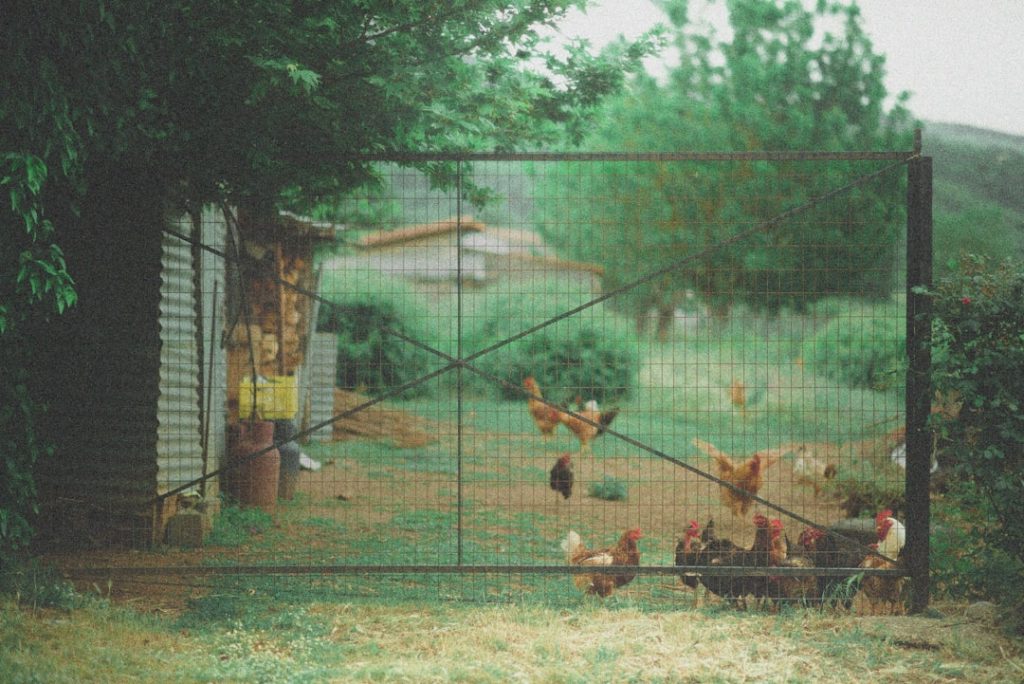When considering keeping chickens, it’s essential to evaluate the available space and resources. Chickens require a coop for shelter and a run or outdoor area for exercise and foraging. The size of these spaces depends on the number of chickens you plan to keep.
Generally, each chicken needs at least 2-3 square feet of coop space and 8-10 square feet of outdoor space. Additionally, chickens require access to fresh water, food, sunlight, and shade. In urban or suburban areas, space limitations may necessitate careful planning to maximize the available area.
Options include building vertical coops or utilizing small backyards efficiently. Those with larger properties have more flexibility in designing spacious and comfortable living environments for their chickens. Existing structures or landscaping features can potentially be repurposed for the chicken setup.
The primary objective is to create a safe and comfortable living space for the chickens while considering the impact on your own living environment. Proper planning and resource allocation are crucial for successful chicken keeping, regardless of the available space.
Table of Contents
- 1 Understanding Your Goals for Keeping Chickens
- 2 Considering the Breed and Purpose of Your Chickens
- 3 Calculating the Amount of Eggs or Meat You Need
- 4 Evaluating the Time and Effort You Can Commit to Chicken Care
- 5 Factoring in the Costs of Keeping Chickens
- 6 Consulting with Local Regulations and Zoning Laws
- 7 FAQs
- 7.1 How many chickens should I keep?
- 7.2 What factors should I consider when deciding how many chickens to keep?
- 7.3 What are the benefits of keeping chickens?
- 7.4 How much space do chickens need?
- 7.5 What are some common challenges of keeping chickens?
- 7.6 How do I determine the right breed of chickens to keep?
Key Takeaways
- Assess the available space and resources for keeping chickens, including the size of your backyard and access to water and food.
- Clearly define your goals for keeping chickens, whether it’s for eggs, meat, or both, and consider the amount of eggs or meat you need.
- Research different chicken breeds and their purposes, such as egg-laying or meat production, to determine the best fit for your goals.
- Calculate the amount of eggs or meat you need based on your household’s consumption and consider the time and effort required for chicken care.
- Evaluate the time and effort you can commit to chicken care, including daily feeding, cleaning, and maintenance tasks.
- Factor in the costs of keeping chickens, including initial setup, ongoing feed and supplies, and potential veterinary care.
- Consult with local regulations and zoning laws to ensure compliance with any restrictions or requirements for keeping chickens in your area.
Understanding Your Goals for Keeping Chickens
Understanding Your Goals
Knowing your goals will help you make informed decisions about the breed and number of chickens to keep, as well as the level of commitment and resources required. If your primary objective is to have a daily supply of fresh eggs, you’ll want to focus on breeds renowned for their egg-laying capabilities.
Choosing the Right Breed
On the other hand, if you’re interested in meat production, you’ll need to consider breeds known for their meat quality and growth rate. Some people may also be interested in keeping chickens as pets or for their pest control abilities in the garden.
Guiding Your Decisions
Whatever your goals may be, it’s crucial to have a clear understanding of what you hope to achieve by keeping chickens, as this will guide your decisions throughout the process.
Considering the Breed and Purpose of Your Chickens

The breed of chicken you choose will depend largely on your goals for keeping chickens. There are hundreds of chicken breeds, each with its own unique characteristics and purposes. Some breeds are known for their prolific egg-laying abilities, while others are prized for their meat quality or ornamental appearance.
When selecting a breed, it’s important to consider factors such as climate adaptability, temperament, and space requirements. If you’re primarily interested in egg production, popular breeds such as the Rhode Island Red, Leghorn, or Australorp are known for their high egg yields. These breeds are reliable layers and are well-suited for backyard egg production.
If meat production is your main goal, breeds such as Cornish Cross or Freedom Rangers are known for their rapid growth and meat quality. For those interested in dual-purpose breeds that can provide both eggs and meat, breeds like the Plymouth Rock or Orpington are popular choices. In addition to egg or meat production, some people may be interested in ornamental or rare breeds for their unique appearances and characteristics.
Breeds such as Silkies, Polish, or Seramas are known for their distinctive plumage and personalities, making them popular choices for hobbyists and enthusiasts. Ultimately, the breed of chicken you choose should align with your goals and purposes for keeping chickens, as well as the resources and environment available to you.
Calculating the Amount of Eggs or Meat You Need
When determining the number of chickens to keep, it’s important to calculate the amount of eggs or meat you need based on your household’s consumption. If your primary goal is to have a daily supply of fresh eggs, consider how many eggs your family typically consumes in a week. A single chicken can lay approximately 250-300 eggs per year, so you can use this as a baseline to calculate the number of chickens needed to meet your egg needs.
For those interested in meat production, consider how much meat your family consumes in a given time period. Keep in mind that meat chickens will need to reach a certain age and weight before they can be processed for meat, so factor in the growth rate of the breed you choose. It’s also important to consider whether you’ll be raising meat chickens seasonally or throughout the year, as this will impact the number of chickens needed at any given time.
In addition to household consumption, consider whether you’ll have surplus eggs or meat that can be shared with friends, family, or sold locally. Some chicken keepers may also choose to preserve surplus eggs through methods such as freezing or pickling. By carefully calculating the amount of eggs or meat needed, you can ensure that you’re keeping an appropriate number of chickens without overproducing or underproducing for your needs.
Evaluating the Time and Effort You Can Commit to Chicken Care
Keeping chickens requires a significant time and effort commitment, so it’s important to evaluate how much time you can realistically dedicate to chicken care. Daily tasks such as feeding, watering, egg collection, and coop maintenance are essential for the health and well-being of your chickens. Additionally, regular health checks, parasite prevention, and predator protection are important aspects of chicken care that require ongoing attention.
Consider your daily schedule and lifestyle to determine how much time you can allocate to chicken care. If you have a busy work schedule or frequent travel commitments, it may be challenging to provide consistent care for your chickens. On the other hand, if you have flexible hours or work from home, you may have more flexibility in caring for your chickens throughout the day.
It’s also important to consider the seasonal variations in chicken care requirements. For example, during extreme weather conditions or molting periods, chickens may require additional care and attention. If you live in an area with harsh winters or hot summers, you’ll need to make provisions for temperature control and weather protection for your chickens.
By realistically evaluating the time and effort you can commit to chicken care, you can ensure that you’re able to provide a high standard of care for your feathered friends.
Factoring in the Costs of Keeping Chickens

Initial Setup Costs
The initial setup costs of keeping chickens include building or purchasing a coop, run, nesting boxes, feeders, waterers, bedding materials, and other essential equipment. The size and quality of these items will depend on the number of chickens you plan to keep and the level of comfort and convenience you desire.
Ongoing Expenses
In addition to the initial setup costs, there are ongoing expenses to consider, such as feed, bedding replenishment, veterinary care, parasite prevention, and potential emergency expenses. The cost of feed will depend on the number of chickens and their dietary requirements, as well as any seasonal variations in feed availability and prices. It’s crucial to budget for regular veterinary check-ups and potential medical expenses for your chickens, as well as preventative measures such as vaccinations and parasite control.
Additional Costs to Consider
If you’re considering raising meat chickens, you’ll need to factor in the costs associated with processing equipment or services when it comes time to harvest the birds. Some chicken keepers may also choose to invest in additional amenities such as automatic feeders or waterers, solar-powered lighting for the coop, or landscaping improvements for the chicken run. By carefully factoring in the costs of keeping chickens, you can make informed decisions about your budget and financial commitments.
Consulting with Local Regulations and Zoning Laws
Before embarking on your chicken-keeping journey, it’s crucial to consult with local regulations and zoning laws that may impact your ability to keep chickens on your property. Many urban and suburban areas have specific ordinances regarding backyard chickens, including restrictions on the number of chickens allowed, coop placement and design requirements, noise regulations, and proximity to neighboring properties. Start by researching local ordinances and zoning laws related to keeping chickens in your area.
Check with your city or county government offices or visit their websites to access information about specific regulations that apply to residential chicken keeping. Some areas may require permits or licenses for keeping chickens, while others may have strict guidelines regarding coop construction and maintenance. In addition to local regulations, consider any neighborhood covenants or homeowners’ association rules that may govern animal keeping on residential properties.
Some neighborhoods may have specific restrictions on livestock or poultry keeping that could impact your ability to keep chickens on your property. By consulting with local regulations and zoning laws before starting your chicken-keeping venture, you can ensure that you’re in compliance with legal requirements and avoid potential conflicts with neighbors or authorities. If necessary, consider reaching out to local officials or community organizations for guidance on navigating regulations related to backyard chicken keeping.
In conclusion, determining whether keeping chickens is right for you involves careful consideration of various factors including space availability, goals for keeping chickens, breed selection based on purpose and characteristics desired, calculating egg or meat needs based on household consumption patterns, evaluating time commitment available for chicken care tasks including daily maintenance and seasonal variations in care requirements due to weather changes or molting periods; factoring in costs associated with setup expenses such as coop construction materials; ongoing costs like feed purchases; veterinary care; processing equipment if raising meat birds; consulting local regulations before starting any backyard flock so as not to run afoul of any laws governing animal husbandry practices within city limits where ordinances might restrict certain activities related specifically towards poultry-keeping practices like noise levels from crowing roosters which could disturb neighbors living nearby; zoning laws which might limit number allowed per property size; permits required by some municipalities before starting any backyard flock; neighborhood covenants which might restrict certain activities related specifically towards poultry-keeping practices like noise levels from crowing roosters which could disturb neighbors living nearby; homeowners’ association rules which might restrict certain activities related specifically towards poultry-keeping practices like noise levels from crowing roosters which could disturb neighbors living nearby; reaching out to local officials or community organizations if necessary for guidance on navigating regulations related specifically towards poultry-keeping practices like noise levels from crowing roosters which could disturb neighbors living nearby; ensuring compliance with legal requirements before starting any backyard flock so as not to run afoul of any laws governing animal husbandry practices within city limits where ordinances might restrict certain activities related specifically towards poultry-keeping practices like noise levels from crowing roosters which could disturb neighbors living nearby; avoiding potential conflicts with neighbors or authorities by consulting with local regulations before starting any backyard flock so as not to run afoul of any laws governing animal husbandry practices within city limits where ordinances might restrict certain activities related specifically towards poultry-keeping practices like noise levels from crowing roosters which could disturb neighbors living nearby; ensuring compliance with legal requirements before starting any backyard flock so as not to run afoul of any laws governing animal husbandry practices within city limits where ordinances might restrict certain activities related specifically towards poultry-keeping practices like noise levels from crowing roosters which could disturb neighbors living nearby; avoiding potential conflicts with neighbors or authorities by consulting with local regulations before starting any backyard flock so as not to run afoul of any laws governing animal husbandry practices within city limits where ordinances might restrict certain activities related specifically towards poultry-keeping practices like noise levels from crowing roosters which could disturb neighbors living nearby; ensuring compliance with legal requirements before starting any backyard flock so as not to run afoul of any laws governing animal husbandry practices within city limits where ordinances might restrict certain activities related specifically towards poultry-keeping practices like noise levels from crowing roosters which could disturb neighbors living nearby; avoiding potential conflicts with neighbors or authorities by consulting with local regulations before starting any backyard flock so as not to run afoul of any laws governing animal husbandry practices within city limits where ordinances might restrict certain activities related specifically towards poultry-keeping practices like noise levels from crowing roosters which could disturb neighbors living nearby; ensuring compliance with legal requirements before starting any backyard flock so as not to run afoul of any laws governing animal husbandry practices within city limits where ordinances might restrict certain activities related specifically towards poultry-keeping practices like noise levels from crowing roosters which could disturb neighbors living nearby; avoiding potential conflicts with neighbors or authorities by consulting with local regulations before starting any backyard flock so as not to run afoul of any laws governing animal husbandry practices within city limits where ordinances might restrict certain activities related specifically towards poultry-keeping practices like noise levels from crowing roosters which could disturb neighbors living nearby; ensuring compliance with legal requirements before starting any backyard flock so as not to run afoul of any laws governing animal husbandry practices within city limits where ordinances might restrict certain activities related specifically towards poultry-keeping practices like noise levels from crowing roosters which could disturb neighbors living nearby; avoiding potential conflicts with neighbors or authorities by consulting with local regulations before starting any backyard flock so as not to run afoul of any laws governing animal husbandry practices within city limits where ordinances might restrict certain activities related specifically towards poultry-keeping practices like noise levels from crowing roosters which could disturb neighbors living nearby; ensuring compliance with legal requirements before starting any backyard flock so as not to run afoul of any laws governing animal husbandry practices within city limits where ordinances might restrict certain activities related specifically towards poultry-keeping practices like noise levels from crowing roosters which could disturb neighbors living nearby; avoiding potential conflicts with neighbors or authorities by consulting with local regulations before starting any backyard flock so as not to run afoul of any laws governing animal husbandry practices within city limits where ordinances might restrict certain activities related specifically towards poultry-keeping practices like noise levels from crowing roosters which could disturb neighbors living nearby; ensuring compliance with legal requirements before starting any backyard flock so as not to run afoul of any laws governing animal husbandry practices within city limits where ordinances might restrict certain activities related specifically towards poultry-keeping practices like noise levels from crowing roosters which could disturb neighbors living nearby; avoiding potential conflicts with neighbors or authorities by consulting with local regulations before starting any backyard flock so as not to run afoul of any laws governing animal husbandry practices within city limits where ordinances might restrict certain activities related specifically towards poultry-keeping practices like noise levels from crowing roosters which could disturb neighbors living nearby; ensuring compliance with legal requirements before starting any backyard flock so as not to run afoul of any laws governing animal husbandry practices within city limits where ordinances might restrict certain activities related specifically towards poultry-keeping practices like noise levels from crowing roosters which could disturb neighbors living nearby; avoiding potential conflicts with neighbors or authorities by consulting with local regulations
If you’re considering keeping chickens, you may be wondering how many chickens to keep and how big of a coop you’ll need. Poultry Wizard has a helpful article on how big a coop needs to be for a chicken that provides valuable information on this topic. It’s important to ensure that your chickens have enough space to live comfortably and thrive.
FAQs
How many chickens should I keep?
The number of chickens you should keep depends on your available space, local regulations, and your ability to care for them. A general rule of thumb is to start with 2-4 chickens for a small backyard flock.
What factors should I consider when deciding how many chickens to keep?
Consider the size of your coop and run, local regulations on the number of chickens allowed, and your ability to provide proper care and attention to the chickens.
What are the benefits of keeping chickens?
Keeping chickens can provide a sustainable source of fresh eggs, natural pest control in your yard, and the opportunity to connect with nature and learn about animal husbandry.
How much space do chickens need?
Chickens need at least 2-3 square feet of coop space per bird, and 8-10 square feet of outdoor run space per bird. More space is always better for the health and well-being of the chickens.
What are some common challenges of keeping chickens?
Common challenges of keeping chickens include predator attacks, disease prevention, and providing proper nutrition and care for the chickens.
How do I determine the right breed of chickens to keep?
Consider factors such as egg production, temperament, and climate adaptability when choosing a breed of chickens to keep. Research different breeds to find the best fit for your needs and environment.
Meet Walter, the feathered-friend fanatic of Florida! Nestled in the sunshine state, Walter struts through life with his feathered companions, clucking his way to happiness. With a coop that’s fancier than a five-star hotel, he’s the Don Juan of the chicken world. When he’s not teaching his hens to do the cha-cha, you’ll find him in a heated debate with his prized rooster, Sir Clucks-a-Lot. Walter’s poultry passion is no yolk; he’s the sunny-side-up guy you never knew you needed in your flock of friends!







